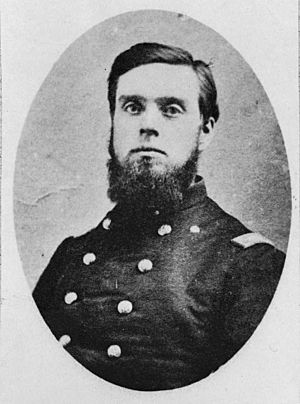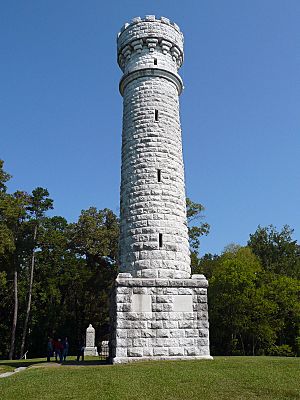John T. Wilder facts for kids
Quick facts for kids
John Thomas Wilder
|
|
|---|---|

John Thomas Wilder
|
|
| Born | January 31, 1830 Catskill Mountains in Hunter, Greene County, New York |
| Died | October 20, 1917 (aged 87) Jacksonville, Florida |
| Buried |
Forest Hills Cemetery, Chattanooga, Tennessee
|
| Allegiance | United States of America Union |
| Service/ |
Union Army |
| Years of service | 1861 – 1864 |
| Rank | |
| Commands held | 17th Indiana Infantry Regiment Lightning Brigade |
| Battles/wars | American Civil War |
John Thomas Wilder (born January 31, 1830 – died October 20, 1917) was an important officer in the Union Army during the American Civil War. He is best known for capturing a key mountain pass called Hoover's Gap in Tennessee in June 1863. This happened during a military operation known as the Tullahoma Campaign. Wilder made sure his special unit, called the "Lightning Brigade", had new and powerful Spencer repeating rifles. At first, his soldiers had to pay for these rifles themselves, but later the government covered the cost. The victory at Hoover's Gap was largely thanks to Wilder's efforts to get these new rifles, which surprised the enemy.
Contents
Early Life and Inventions
John Thomas Wilder was born in the Catskill Mountains in Hunter, Greene County, New York. His family had a long history of serving in the military. His grandfather and great-grandfather, both named Seth Wilder, fought in the American Revolutionary War. His great-grandfather lost a leg in the Battle of Bunker Hill, and his grandfather took his place. John's father, Reuben, also fought in the War of 1812.
Wilder spent his younger years in Hunter, where he went to school. When he was nineteen, he decided to move west to make his own way. Wilder soon arrived in Columbus, Ohio, with almost no money. He found work as a draftsman, drawing plans for buildings and machines. Then he became an apprentice millwright at a local foundry, a place where metal is melted and shaped. This training helped him a lot in his future career.
In 1857, Wilder moved to Indiana, first to Lawrenceburg and then to Greensburg. There, he married Martha Jane Stewart and they had a large family. He started his own small foundry, which quickly became very successful. Wilder invented many hydraulic machines, which use liquid pressure to create power. He received patents for his inventions. He sold equipment and built mills and hydraulic systems in many nearby states. He also became famous across the country as an expert in hydraulics, even patenting a unique water wheel in 1859.
Wilder's Role in the Civil War
When the Civil War began, Wilder put together a light artillery company in the Greensburg area. He even made two cannons at his own foundry. His company joined the state military, but the U.S. government didn't accept it because Indiana already had enough artillery units. Instead, Wilder was made a captain, and his men became Company A of the 17th Indiana Infantry Regiment in Indianapolis.
When the 17th Indiana went to western Virginia in July 1861, Company A took the two cannons with them. Later, Company A became a separate unit called the 26th Independent Battery Indiana Light Artillery. It was often called the "Wilder Battery" because he was its first commander. Meanwhile, Captain Wilder was quickly promoted to lieutenant colonel of the 17th Indiana in June 1861. He served in early campaigns in Virginia and later in Kentucky. In March 1862, Wilder was promoted to colonel and became the commander of the 17th Indiana. During the campaign to take Corinth, Mississippi, Wilder became known as a skilled and talented commander.
Defending Munfordville
In 1862, the Confederate army, led by Gen. Braxton Bragg, moved into Kentucky. Bragg's army approached Munfordville, a train station where Wilder commanded the Union forces. Wilder had three regiments and strong defenses. On September 14, Brig. Gen. James R. Chalmers demanded that Wilder surrender. Wilder refused, saying, "I think we'll fight for a while." His men fought back Chalmers's attacks that day, causing many casualties for the Confederates while losing only a few of their own.
This forced the Confederates to surround the area from September 15–16. By this time, Wilder's 4,000 men were almost completely surrounded by 22,000 Confederates with 100 cannons. The Confederates sent another demand for surrender. Wilder personally went into the enemy lines, blindfolded, under a flag of truce. Maj. Gen. Simon B. Buckner showed him all the Confederate troops to convince him that fighting was hopeless. Impressed, Wilder surrendered his forces. The official ceremony happened on September 17. Wilder was a prisoner of war for two months before being exchanged.

The Lightning Brigade
Wilder became very famous for his actions in the Tullahoma Campaign. He put his brigade on horses and mules that his men found in the local area. They moved so quickly into battle that his men became known as the "Lightning Brigade". This brigade included the 17th Indiana Infantry Regiment, the 72nd Indiana Infantry Regiment, the 98th Illinois Infantry Regiment, the 123rd Illinois Infantry Regiment, and the 18th Independent Battery Indiana Light Artillery. They were also called the "Hatchet Brigade" because Wilder gave them long-handled hatchets to carry instead of cavalry sabers.
His men also carried Spencer repeating rifles. These rifles could fire much faster than the weapons used by the Confederates. To get these rifles, Wilder bypassed the usual army rules. He asked his men to vote on buying the rifles, and they all agreed. He got a loan from his hometown bank, and each man in the brigade signed a personal loan for $35. The government was embarrassed and paid for the weapons before the men had to spend any of their own money.
On June 24, the Lightning Brigade captured and held Hoover's Gap. Wilder was ordered by General Joseph J. Reynolds to fall back to his main infantry, which was six miles away. But Wilder decided to hold his position. He fought off repeated attempts by the enemy to push his force back until the infantry arrived. This was the most important battle in the Tullahoma Campaign. The commanding officer of the Army of the Cumberland, William Rosecrans, soon arrived. Instead of scolding Wilder for disobeying orders, he congratulated him. Rosecrans told him it would have cost thousands of lives to take the position if Wilder had left it.
Wilder also led a diversionary attack against Chattanooga. These artillery attacks, known as the Second Battle of Chattanooga, tricked the Confederates into thinking the Union army would attack Chattanooga from the north.
Battles of Chickamauga and Atlanta
Just before the Battle of Chickamauga, Wilder's brigade played a key role at Alexander's Bridge on September 18, 1863. They defended the crossing of West Chickamauga Creek and helped stop the Confederates from getting around the Union army's side. On the second day at Chickamauga, September 20, Wilder's brigade, with its superior firepower, was one of the few units that was not immediately defeated by the Confederate attack. They launched a strong counterattack, pushing the enemy around an area that became known as "Bloody Pond."
Wilder wanted to use this success to attack the side of the main Confederate column. However, at that moment, Assistant Secretary of War Charles A. Dana found Wilder. Dana was very upset and claimed the battle was lost, demanding to be taken to Chattanooga. While Wilder calmed the secretary and arranged an escort for him, the chance for a successful attack was lost. He then ordered his men to pull back.
Maj. Gen. George H. Thomas officially praised Colonel Wilder for his actions at Chickamauga. Wilder did not directly take part in the main Battles for Chattanooga in November. However, he led the brigade during much of the Atlanta Campaign in the spring and summer of 1864. He was promoted to brevet brigadier general of volunteers on August 7, 1864. Throughout 1863 and 1864, Wilder suffered from dysentery (a severe stomach illness) caused by typhoid fever in 1862. Because of his health, he resigned from the Army in October 1864 and went home.
After the War: Business and Politics
After the war, Wilder settled in Rockwood, Tennessee, and later in Chattanooga. In 1867, he started an ironworks in the Chattanooga area. He then built and ran the first two blast furnaces in the South at Rockwood, Tennessee. In 1870, he started a company in Chattanooga to make rails for railroads.
From 1884 to 1892, he helped promote and build the Charleston, Cincinnati & Chicago Railroad while living in Johnson City, Tennessee. In Johnson City, he developed a fast-growing industrial area called Carnegie, named after the famous industrialist Andrew Carnegie. He also built many iron-making and railroad-related factories. Iron ore was brought to Johnson City by the East Tennessee and Western North Carolina Railroad. Wilder also built a popular 166-room hotel called the Cloudland Hotel near the top of Roan Mountain to serve tourists who used this scenic narrow gauge railway line.
Wilder also entered politics. He was elected mayor of Chattanooga in 1871. He resigned a year later to focus on his business interests. He ran for the United States Congress in 1876 but did not win. In 1877, he became the city postmaster, serving until 1882.
He moved to Knoxville, Tennessee, in 1897 after President William McKinley appointed him as a Federal pension agent. Later, he became a commissioner for the Chickamauga and Chattanooga National Military Park.
John Thomas Wilder died in Jacksonville, Florida, at the age of 87. He was on his yearly winter vacation with his second wife, Dora Lee. He was buried in Forest Hills Cemetery in Chattanooga, next to his first wife, Martha Jane Stewart.
Two of Wilder's homes in Tennessee, the General John T. Wilder House in Knoxville and the John T. Wilder House in Roan Mountain, are listed on the National Register of Historic Places. Another home he built in Greensburg, Indiana, is marked by a historic sign.

